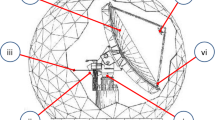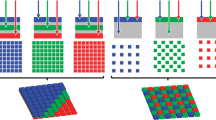Abstract
This paper sets the rules for an optimal definition of precise signal path variation (SPV) models, revising and highlighting the deficiencies in the calculations adopted in previous studies and improving the computational approach. Hence, the linear coefficients that define the SPV model are rigorously determined. The equations that are presented depend on the dimensions and the focal lengths of the telescopes as well as on the feed illumination taper. They hold for any primary focus or Cassegrainian very long baseline interferometry (VLBI) telescope. Earlier investigations usually determined the SPV models assuming a uniform illumination of the telescope mirrors. We prove this hypothesis to be over-simplistic by comparing results derived adopting (a) uniform, (b) Gaussian and (c) binomial illumination functions. Numerical computations are developed for AZ-EL mount, 32 m Medicina and Noto (Italy) VLBI telescopes, these latter being the only telescopes which possess thorough information on gravity-dependent deformation patterns. Particularly, assuming a Gaussian illumination function, the SPV in primary focus over the elevation range [0°, 90°] is 10.1 and 7.2 mm, for Medicina and Noto, respectively. With uniform illumination function the maximal path variation for Medicina is 17.6 and 12.7 mm for Noto, thus highlighting the strong dependency on the choice of the illumination function. According to our findings, a revised SPV model is released for Medicina and a model for Noto is presented here for the first time. Currently, no other VLBI telescope possesses SPV models capable of correcting gravity-dependent observation biases.
Similar content being viewed by others
References
Baars JWM (2007) The paraboloidal reflector antenna in radio astronomy and communication, vol. 348. Springer, New York, 370 pp. doi:10.1007/978-0-387-69734-5. ISSN 0067-0057
Carter E, Rogers AEE, Counselman CC, Shapiro II (1980) Comparison of geodetic and radio interferometric measurements of the Haystack-Westford base line vector. J Geophys Res 85: 2685–2687
Cha AG (1987) Phase and frequency stability of Cassegrainian antennas. Radio Sci 22(1): 156–166
Cha AG, Levy R (1988) Gain, phase, and frequency stability of DSS-42 and DSS-43 for Voyager Uranus encounter. Technical report. Jet Propulsion Laboratory, Pasadena, TDA Prog. Rep., pp 42–84
Cha AG, Rusch WVT, Otoshi T (1978) Microwave delay characteristics of cassegrainian antennas. IEEE Trans Antenn Propagat AP 26(6): 860–865
Christiansen WN, Högbom JA (1969) Radiotelescopes. Cambridge monographs on physics. Cambridge University Press, Cambridge. ISBN :521-7054-6, 231 pp
Clark TA, Thomsen P (1988) Deformations in VLBI antennas. Technical report 100696. NASA, Greenbelt
Clarricoats PJB, Olver AD (1984) Corrugated horns for microwave antennas. IEE electromagnetic waves series, vol. 18. Peter Peregrinus, Ltd., London, 227 pp. ISBN 0 86341 003 0
Gendt G, Nothnagel A, Pavlis E, Lemoine F, Van Dam T, Appleby G (2007) Technique-specific biases and effects at co-location sites/satellites. In: Unified Analysis Workshop 2007. http://www.iers.org/documents/workshop2007/presentations/UAW_PosPap_Session_2_Dec02.pdf
Goldsmith PF (1998) Quasioptical systems: Gaussian beam quasioptical propagation and applications. IEEE Press/Chapman & Hall Publisher series on microwave technology and techniques, IEEE Press Marketing, Piscataway, 08855-1331, 412 pp. ISBN 0 78033 439 6
Nothnagel A (2008) Conventions on thermal expansion modelling of radio telescopes for geodetic and astrometric VLBI. J Geodesy 83(8): 787–792. doi:10.1007/s00190-008-0284-z
Orfei A, Morsiani M, Zacchiroli G, Maccaferri G, Roda J, Fiocchi F (2004) An active surface for large reflector antennas. IEEE Antenn Propag Mag 46(4): 11–19. doi:10.1109/MAP.2004.1373995
Otoshi TY, Young LE (1982) An experimental investigation on the changes of VLBI time delays due to antenna structural deformations. Technical report. Jet Propulsion Laboratory, Pasadena, TDA Prog. Rep., pp 42–68
Sarti P, Abbondanza C, Vittuari L (2009a) Gravity dependent signal path variation in a large VLBI telescope modelled with a combination of surveying methods. J Geodesy 83(11): 1115–1126. doi:10.1007/s00190-009-0331-4
Sarti P, Vittuari L, Abbondanza C (2009b) Laser scanner and terrestrial surveying applied to gravitational deformation monitoring of large VLBI telescopes’ primary reflector. J Surv Eng 135(4): 136–148. doi:10.1061/(ASCE)SU.1943-5428.0000008
Sarti P, Abbondanza C, Petrov L, Negusini M (2010) Height bias and scale effect induced by antenna gravity deformations in geodetic VLBI data analysis. J Geodesy (submitted)
Wylde RJ, Martin DH (1993) Gaussian beam-mode analysis and phase-centers of corrugated feed horns. IEEE Trans Microw Theory 41(10): 1691–1699
Author information
Authors and Affiliations
Corresponding author
Electronic Supplementary Material
The Below is the Electronic Supplementary Material.
Rights and permissions
About this article
Cite this article
Abbondanza, C., Sarti, P. Effects of illumination functions on the computation of gravity-dependent signal path variation models in primary focus and Cassegrainian VLBI telescopes. J Geod 84, 515–525 (2010). https://doi.org/10.1007/s00190-010-0389-z
Received:
Accepted:
Published:
Issue Date:
DOI: https://doi.org/10.1007/s00190-010-0389-z




